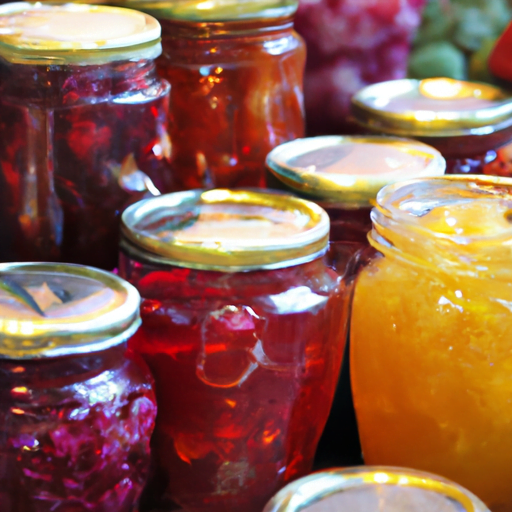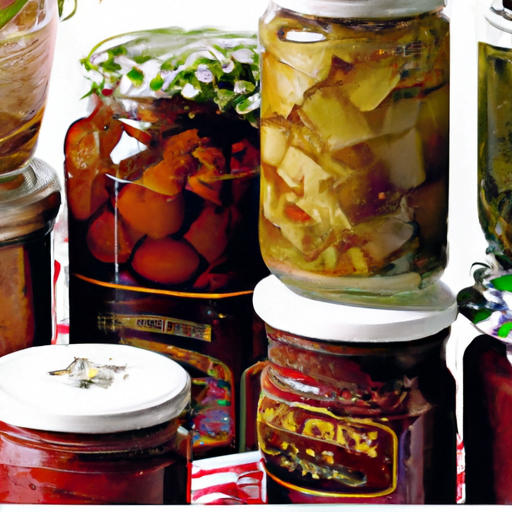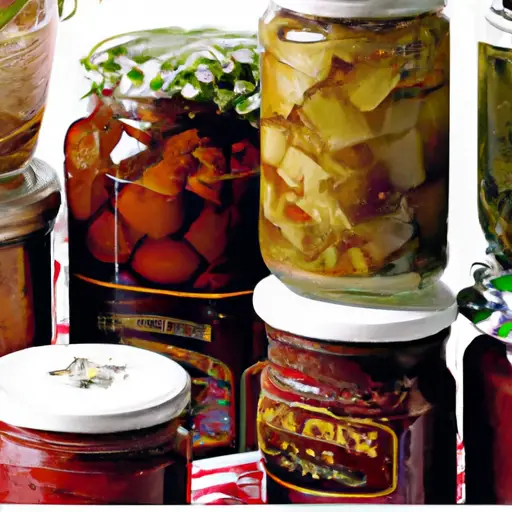So, you’re interested in off-grid living and want to learn how to preserve your fruit without a freezer? Well, you’ve come to the right place! Preserving fruits without a freezer can be a great way to extend the shelf life of your harvest and ensure you have delicious fruits to enjoy all year round. In this article, we’re going to explore 10 different methods you can use to preserve your fruit without the need for electricity. By the end, you’ll be equipped with a variety of techniques that will allow you to enjoy the taste of summer no matter the season.
Now, let’s get into the juicy details, shall we? One popular method of preserving fruit without a freezer is through canning. Canning involves cooking the fruit in a hot syrup or juice, sealing it in jars, and then processing it in boiling water. This kills any microorganisms that may cause spoilage and creates a vacuum seal that keeps the fruit preserved for long periods of time.
Another method to consider is drying your fruit. This can be done through air drying or using a food dehydrator. Drying removes the moisture from the fruit, which inhibits the growth of bacteria and mold. The result is a preserved fruit that can be stored in a cool, dry place for several months.
These are just a couple of the methods we’ll be delving into in this article. Whether you’re interested in pickling, making jams and jellies, or even fermenting your fruit, we’ve got the information you need to preserve your fruit without a freezer. So, let’s dive in and explore the wonderful world of off-grid fruit preservation! Preserving fruit is a great way to enjoy the flavors of summer all year round. But what if you don’t have access to a freezer? Don’t worry, there are still plenty of methods you can use to preserve your favorite fruits without the need for freezing. In this article, we will explore 10 ways to preserve fruit without a freezer, ranging from canning and dehydrating to making jams and jellies. So let’s dive in and discover the best preservation techniques for your fruit!

1. Canning
One of the most popular methods of fruit preservation is canning. Canning involves heating fruit in jars to kill any bacteria and sealing them tightly to create a vacuum. There are two main types of canning: water bath canning and pressure canning.
1.1 Water Bath Canning
Water bath canning is suitable for preserving high-acid fruits like berries, cherries, and citrus fruits. To water bath can, you will need a large pot with a lid, canning jars, a jar lifter, and canning lids and bands. The basic process involves sterilizing the jars, filling them with fruit and syrup, sealing the jars, and boiling them in a water bath for a specific period of time.
1.2 Pressure Canning
Pressure canning is necessary for low-acid fruits like peaches, pears, and apples. It involves using a pressure canner, which uses high heat and pressure to kill any bacteria that can cause spoilage. The process is similar to water bath canning, but the jars are processed at a higher temperature and pressure.
1.3 Steps Involved in Canning Process
The canning process involves several steps, including preparing the fruit, sterilizing the jars, making the syrup or liquid, filling the jars, removing air bubbles, applying lids and bands, and processing the jars either in a water bath or pressure canner. Each step is crucial for ensuring the safety and longevity of your canned fruit.
2. Dehydrating
Dehydrating fruit is another effective way to preserve it without a freezer. Dehydration removes the moisture from the fruit, inhibiting the growth of bacteria and enzymes that cause spoilage. There are several methods you can use to dehydrate fruit, including sun-drying, oven-drying, and using a dehydrator.
2.1 Sun-Drying
Sun-drying involves placing sliced fruit on racks or screens and allowing the natural heat of the sun to dry it out. This method requires warm, dry weather and can take anywhere from a few days to a week or more depending on the moisture content of the fruit and the climate.
2.2 Oven-Drying
Oven-drying is a faster option for dehydrating fruit. It involves setting your oven to a low temperature, usually around 140°F (60°C), and placing the sliced fruit on baking sheets. The oven door is left slightly ajar to allow moisture to escape, and the fruit is dried for several hours until it becomes leathery or crisp.
2.3 Using a Dehydrator
A dehydrator is a kitchen appliance specifically designed for drying fruits, vegetables, and other foods. It provides a controlled and even drying environment, allowing you to dehydrate fruit quickly and efficiently. Simply slice the fruit, arrange it on the dehydrator trays, and set the temperature and time according to the manufacturer’s instructions.
2.4 Storage Tips for Dehydrated Fruit
Once your fruit is dehydrated, it’s important to store it properly to maintain its quality. Store dehydrated fruit in airtight containers or resealable bags in a cool, dry, and dark place. Properly stored dehydrated fruit can last for several months to a year, depending on the type of fruit and the conditions of storage.
3. Making Fruit Leathers
Fruit leathers are a delicious and nutritious way to preserve fruit without a freezer. They are essentially fruit puree that is spread out and dried into a flexible, leathery sheet. Making fruit leathers is a great way to use up overripe or slightly blemished fruit.
3.1 Choosing the Right Fruits
Almost any fruit can be made into a fruit leather, but some fruits work better than others. Fruits with high pectin content, like apples and berries, tend to produce thicker leathers. Sweet and tangy fruits like peaches, apricots, and mangoes also make excellent fruit leathers.
3.2 Preparation and Cooking
To make fruit leathers, start by washing, peeling, and removing any seeds or pits from the fruit. Puree the fruit in a blender or food processor until smooth. If desired, you can add sweeteners, spices, or other flavorings to enhance the taste. Then, pour the puree onto a baking sheet lined with parchment paper or a silicone mat.
3.3 Drying and Storing
Place the baking sheet in an oven set at a low temperature, usually around 140°F (60°C), and leave the door slightly ajar to allow moisture to escape. The fruit leather will take several hours to dry completely. Once dry, remove the leather from the baking sheet and cut it into strips or shapes. Store the fruit leathers in airtight containers or bags in a cool, dry place.

4. Creating Jams and Jellies
Creating homemade jams and jellies is a classic way to preserve fruit. Jam is made by cooking fruit with sugar and sometimes pectin until it thickens into a spreadable consistency. Jelly, on the other hand, is made by straining the juice from the fruit and cooking it with sugar and pectin.
4.1 Basic Recipe for Fruit Jam
To make fruit jam, start by washing and preparing the fruit. Most fruits need to be chopped or crushed before cooking. Combine the fruit and sugar in a large pot and bring to a boil, stirring frequently. Once it reaches a rolling boil, cook the fruit mixture until it thickens and passes the gel test. Pour the hot jam into sterilized jars, leaving a ¼ inch (0.6 cm) of headspace, and seal tightly.
4.2 Making Fruit Jelly
To make fruit jelly, start by crushing or chopping the fruit and placing it in a cheesecloth or jelly bag. Suspend the bag over a bowl and let it drip for several hours or overnight to extract the juice. Measure the juice and combine it with sugar and pectin in a pot. Bring the mixture to a boil, stirring constantly, and cook until it reaches the gel point. Pour the hot jelly into sterilized jars, leaving a ¼ inch (0.6 cm) of headspace, and seal tightly.
4.3 Tips for Successful Jam and Jelly Making
Successful jam and jelly making requires careful attention to detail. Use ripe, high-quality fruit and follow a reliable recipe. Measure ingredients accurately and cook the fruit mixture until it thickens appropriately. Properly sealed and stored jars can last for up to a year in a cool, dark place.
5. Pickling
Pickling fruits is a unique and flavorful way to preserve them without a freezer. Pickling involves preserving the fruit in a solution of vinegar, water, sugar, and spices. There are two main methods of pickling: quick pickling and fermentation pickling.
5.1 Quick Pickling
Quick pickling is a simple way to pickle fruit that can be enjoyed relatively quickly. To quick pickle, prepare the fruit by slicing or cutting it into desired shapes. Heat a mixture of vinegar, water, sugar, and spices until it comes to a boil. Pour the hot liquid over the fruit in canning jars, making sure the fruit is fully submerged. Let the jars cool to room temperature before sealing them tightly and storing them in the refrigerator. Quick pickled fruit can usually be enjoyed within a few days.
5.2 Fermentation Pickling
Fermentation pickling is a longer process that relies on natural bacteria and enzymes to create sour flavors and preserve the fruit. To ferment pickle, prepare the fruit and place it in a jar along with a brine made of salt and water. Cover the jar with a cloth and secure it with a rubber band. Allow the fruit to ferment at room temperature for several days or weeks, depending on your desired level of tanginess. Once fermented, transfer the jar to the refrigerator to slow down the fermentation process. Fermented pickled fruit can last for several months in the refrigerator.
5.3 Proper Storage of Pickled Fruit
Proper storage of pickled fruit is essential to maintain its quality and flavor. Quick pickled fruit should be stored in the refrigerator and consumed within a few weeks. Fermented pickled fruit should also be stored in the refrigerator and can last for several months.
6. Making Fruit Syrups
Making fruit syrups is a versatile way to preserve fruit and add flavor to various dishes and beverages. Fruit syrups are made by cooking fruit with sugar and sometimes water or other liquids until it thickens into a syrupy consistency.
6.1 Simple Fruit Syrup Recipe
To make a simple fruit syrup, start by washing and preparing the fruit. Most fruits need to be chopped or crushed before cooking. Combine the fruit, sugar, and water in a pot and bring to a boil. Simmer the mixture until the fruit breaks down and the liquid thickens. Strain the syrup through a fine-mesh sieve or cheesecloth to remove any solids. Pour the hot syrup into sterilized jars, leaving a ¼ inch (0.6 cm) of headspace, and seal tightly.
6.2 Infused Fruit Syrups
Infused fruit syrups add additional flavors to the base fruit syrup. You can infuse the syrup with herbs, spices, or even other fruits to create unique and delicious flavor combinations. Simply add the desired infusion ingredients to the pot along with the fruit and sugar, and proceed with the recipe as usual.
6.3 Usage and Storage Tips
Fruit syrups can be used in a variety of ways. They can be drizzled over pancakes, waffles, ice cream, or yogurt. They can also be used as a flavoring agent in cocktails, mocktails, or homemade sodas. Properly sealed and stored jars of fruit syrup can last for several months in a cool, dark place.
7. Freezing in Fruit Juice
Freezing fruit in fruit juice is a simple and effective method of preserving fruit without a freezer. The fruit juice helps protect the fruit from freezer burn and also adds flavor when the fruit is later used or thawed.
7.1 Preparing the Fruit
To freeze fruit in fruit juice, start by washing, peeling, and removing any pits or seeds from the fruit. Cut the fruit into desired shapes or leave them whole, depending on your preference. Arrange the fruit in a single layer on a baking sheet lined with parchment paper or a silicone mat.
7.2 Freezing in Fruit Juice
Pour fruit juice over the fruit, making sure the juice covers the fruit completely. Place the baking sheet in the freezer and freeze until the fruit is firm, usually several hours or overnight. Once frozen, transfer the fruit to airtight containers or resealable bags, removing as much air as possible before sealing.
7.3 Thawing and Usage Suggestions
When you’re ready to use the frozen fruit, simply thaw it in the refrigerator or at room temperature. Thawed fruit can be enjoyed as is or used in various recipes like smoothies, pies, or fruit salads. The flavorful fruit juice can also be used as a base for sauces, dressings, or marinades.
8. Making Fruit Vinegar
Fruit vinegar is a unique and tangy way to preserve fruit without a freezer. It is made by fermenting fruit juice with the help of natural bacteria and yeast, which convert the fruit sugars into acetic acid. Fruit vinegar can be used in cooking, salad dressings, and even as a natural cleaning solution.
8.1 Fruit Vinegar Basics
To make fruit vinegar, start by extracting the juice from ripe fruit. This can be done by crushing or pressing the fruit and straining out the juice. Place the juice in a clean container and cover it with a cloth or coffee filter to allow air circulation while keeping out dust and insects. Let the juice ferment at room temperature for several weeks, checking for the presence of a scoby (symbiotic culture of bacteria and yeast) on the surface. Once the scoby forms, it indicates that the fermentation process is underway.
8.2 Fruit Vinegar Making Process
Continue to let the fruit juice ferment for several weeks or months until it reaches your desired level of acidity and flavor. The longer you ferment the juice, the stronger and more complex the vinegar will become. Once you are satisfied with the taste, strain out the scoby and any solids and transfer the vinegar to sterilized bottles or jars. Seal the containers tightly and store them in a cool, dark place.
8.3 Culinary Uses of Fruit Vinegar
Fruit vinegar can be used in a variety of culinary applications. It can be used as a salad dressing, marinade, or as an ingredient in sauces and dressings. Fruit vinegar also adds a tangy and fruity flavor when used in desserts or mixed with sparkling water for a refreshing beverage.
Conclusion
Preserving fruit without a freezer opens up a world of possibilities for enjoying the flavors of ripe, fresh fruit all year round. From canning and dehydrating to making jams, jellies, and vinegars, there are numerous techniques to choose from. Each method has its own advantages and disadvantages, so it’s important to consider your specific fruit preservation needs. Whether you prefer the simplicity of dehydrating or the traditional charm of canning, you can find a fruit preservation method that suits your taste and resources. So embrace the art of fruit preservation and savor the flavors of summer no matter the season!




